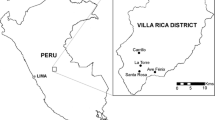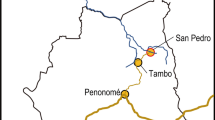Abstract
The objective of this research was to determine the relationships between different ecological features of shade and the incidence of coffee berry borer, coffee leaf rust and spontaneous herbs in rustic coffee plantations in Chiapas, Mexico. Thirty-six 10 m by 10 m plots were established within coffee plantations. The following variables were measured or estimated: number of vegetation strata, percent canopy cover, direct, diffuse and total sunlight below the canopy, plant species richness and diversity, shade tree/shrub density, altitude, aspect, basal area, yields, percentage of coffee berry borer (Hypothenemus hampei Ferr), percentage of coffee leaf rust (Hemileia vastatrix Berk & Br.),percentage of spontaneous herb cover and the presence of paths and runoffs.Results showed a complex agroforestry system, composed of five strata. Coffee berry borer and coffee leaf rust incidence averages were 1.5% and 10.1%,respectively. Average spontaneous herb cover was 34.1%. Coffee leaf rust percentage correlated positively with the coffee berry borer. Number of strata of shade vegetation correlated negatively with leaf rust, while the presence of paths correlated positively with the leaf rust. Species richness and diversity correlated negatively to broad-leaf-herb cover and the presence of runoffs correlated positively to this last variable. Shade tree density (> 10cm d.b.h.) correlated negatively to linear-leaf-herb cover. Percentage of shade cover, light, coffee density, aspect, stand age, basal area and yields were not correlated to pest, disease and weeds. Results support the ecological theory that postulates that diversity and structural complexity in mixed plant systems maintain a healthy system.
Similar content being viewed by others
References
Altieri M.A. and Letorneau D.K. 1982. Vegetation management and biological control in agroecosystems. Crop Protection 1: 405.
Altieri M.A. 1993. Ethnoscience and biodiversity: key elements in the design of sustainable pest management systems for small farmers in developing countries. Agriculture, Ecosystems and Environment 46: 257–272.
Anderson M.C. 1964. Studies of the woodland light climate. I. The photographic computation of light conditions. Journal of Ecology 52: 27–41.
Avelino J.R.A., Muller C., Cilas H. and Velasco P. 1991. Desarrollo y comportamiento de la roya anaranjada del cafeto (Hemileia vastatrix Berk & Br.) en plantaciones en proceso de modernización, cultivadas con variedades de porte bajo en el sureste de México. Café Cacao The 35: 38–42.
Aylor D.E. 1990. The role of intermittent wind in the dispersal of fungal pathogens. Annual Review of Phytopathology 28: 73–92.
Baker P.S. 1984. Some aspects of the behaviour of the coffee berry borer in relation to its control in southern Mexico (Coleoptera, Scolytidae). Folia Entomologica Mexicana 61: 9–24.
Beer J., Muschler R., Kass D and Somarriba E. 1998. Shade management in coffee and cacao plantations. Agroforestry Systems 38: 139–164.
Brown J.S., Whan J.H., Kenny M.K. and Merriman P.R. 1995. The effect of coffee leaf rust on foliation and yield of coffee in Papua New Guinea. Crop Protection 14: 589–592.
Eskes A.B. 1982. The effect of light intensity on incomplete resistance of coffee to Hemileia vastatrix. Netherlands Journal of Plant Pathology 88: 191–202.
Godínez M.J. 1997. Caracterización del sistema agroforesal café orgÁnico bajo sombra en tres municipios de la Región Fronteriza del estado de Chiapas., Universidad Autónoma de Chapingo, México.
Hodges C.F., Campbell D.A. and Christians N. 1993. Evaluation of Streptomyces for biocontrol of Bipolaris sorokiniana and Sclerotina homoeocarpa on the phylloplane of Poa pratensis. Journal of Phytopathology 139: 103–109.
Jarquín G.R., Barrera J.F., Nelson K. and Martínez Quezada A. 1999. Métodos no químicos contra la broca del café y su transferencia tecnológica en los Altos de Chiapas, Mexico. Agrociencia (Mexico) 33: 431–438.
Jiménez-Avila E. 1979. Estudios ecológicos del agroecosistema cafetalero: I. Estructura de los cafetales de una finca en Coatepec, Ver. México. Biotica (Mex.) 4: 1–12.
Margalef D.R. 1958. Information theory in ecology. Gen Syst 3: 36–71.
Moguel P. and Toledo V.M. 1996. El café en México, ecología, cultura indígena y sustentabilidad. Ciencias 43: 40–51.
Moreno R.A. and Mora L.E. 1984. Cropping pattern and soil management influence on plant diseases. II. Bean rust epidemiology. Turrialba 34: 41–45.
Nagarajan S. and Singh D.V. 1990. Long-distance dispersion of rust pathogens. Annual Review of Phytopathology 28: 139–153.
Nestel D. 1992. The weed community of Mexican coffee agroeco-systems-effect of management upon plant biomass and species composition. Acta Oecologica-International Journal of Ecology 13: 715–726.
Perfecto I., Rice R., Greenberg R. and van der Voort M.E. 1996. Shade coffee: a disappearing refuge for biodiversity. BioScience 46: 598–608.
Perrin R.M. 1977. Pest management in multiple cropping systems. Agroecosystems 3: 93–113.
Püelschen L. and Lutzeyer H.J. 1993. Ecological and economic conditions of organic coffee production in Latin America and Papua New Guinea. Angewandte Botanik 67(5–6): 204–208.
Roberts D.W. 1986. Ordination on the basis of fuzzy set theory. Vegetatio 66: 123–131.
Roxburgh J.R. and Kelly D. 1995. Uses and limitations of hemispherical photography for estimating forest light environments. N. Z. Jour. of Ecol. 19(2): 213–217.
Soto-Pinto L., Perfecto I., Castillo J. and Caballero-Nieto J. 2000. Shade effect on coffee production at the northern Tzeltal zone of the state of Chiapas, Mexico. Agriculture, Ecosystems & Environment 80: 61–69.
Wringley G. 1988. Coffee. Longman, New York, United States.
Author information
Authors and Affiliations
Corresponding author
Rights and permissions
About this article
Cite this article
Soto-Pinto, L., Perfecto, I. & Caballero-Nieto, J. Shade over coffee: its effects on berry borer, leaf rust and spontaneous herbs in Chiapas, Mexico. Agroforestry Systems 55, 37–45 (2002). https://doi.org/10.1023/A:1020266709570
Issue Date:
DOI: https://doi.org/10.1023/A:1020266709570




